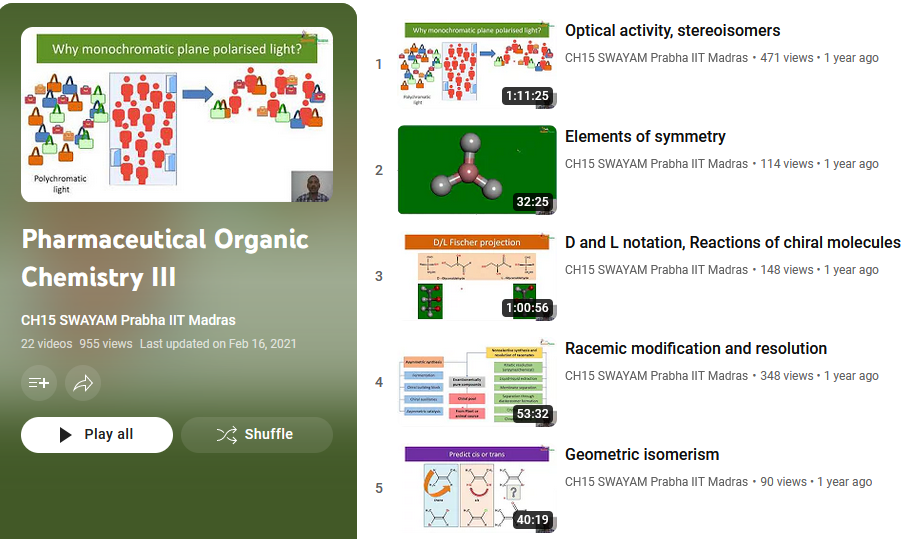
Syllabus
Week 1
Introduction
to chemical evolution, Carbon fixation-Calvin cycle
Introduction
to molecular interactions, types of bonds
Common
bonding pattern for carbon, oxygen and nitrogen
VSEPR
theory
Tutorial:
VB theory
Week 2
VB theory,
hybridisation in methane, ammonia, amide, water, alkene, alkyne
MO theory,
orbital overlap (s-s, s-p, p-p), bond order, s-p mixing
Week 3
Electronic
effects 1: Inductive effects and its significance
Electronic
effects 2: Resonance effects and its significance
Week 4
Electronic
effects 3: Hyperconjugation and its significance
Tutorial: Acids and
bases: Arrhenius, Brønsted-Lowry, and Lewis theories
Week 5
Functional
groups and their importance
Tutorial : Formal charge
Week 6
Reactivity
and intermediates
Carbocations,
Carbanions, Free radicals and Carbenes
Week 7
Types of
organic reactions and their mechanism
Addition,
Elimination, Substitution and radical reactions
Stereochemistry
1: Fischer, Newmann and Sawhorse Projections
Tutorial: Fischer-DL
Week 8
Stereochemistry
2: Geometrical isomerism – cis/trans, E/Z notation, CIP rule
Optical
Isomerism -enantiomer, diastereomer
Tutorial: Geometrical isomerism
Tutorial: enantiomer, diastereomer
Week 9
Chemistry
of alkanes: formation, Wurtz Reaction, Wurtz-Fittig Reactions, Reactions of
alkanes
Week 10
Electrophilic
additions
Markownikoff
and Anti Markownikoff addition
Reactions
of alkenes 1: Oxymercuration-demercuration, Hydroboration-oxidation, Ozonolysis
Tutorial: E2
Tutorial: Electrophilic additions
Week 11
Reactions
of alkenes 2: Catalytic reduction, 1,2-and 1,4-addition, Diels-Alder reaction
Week 12
Reactions
of alkenes 3: Di-hydroxylation, Allylic and benzylic bromination and mechanism
Reactions
of alkynes
Week 13
Conformation
of cycloalkanes 1
Conformation
of cycloalkanes 2
Conformation
of cyclohexane
Week 14
Aromaticity
1: Huckel’s rule, aromatic character of cyclic C3 and C4 systems
Aromaticity
2: aromatic character of cyclic C5-C7 systems, heterocycles
Week 15
Aromatic
Electrophilic substitutions 1: Halogenation
Aromatic
Electrophilic substitutions 2: Hammick and Illingworth empirical rule,
Orientation
Aromatic Electrophilic substitutions 3:
Nitration, sulphonation, Friedel-Crafts alkylations and acylation
March's Advanced Organic Chemistry Reactions, Mechanisms and Structure 5th Ed. Michael B. Smith, Jerry March, John Wiley & Sons, Inc., 2001.
F. A. Carey: Organic Chemistry, 5th Ed., McGraw-Hill, 2004.
Peter Sykes, A Guidebook to Mechanism in Organic Chemistry, 6th Ed, John Wiley and Sons. Inc, New York, 1986.
J. Clayden, N. Greeves, S. Warren, Organic Chemistry, 2nd Ed., Oxford University Press, New Delhi, 2012.
F. A. Carey and R. J. Sundberg, Advanced Organic Chemistry, Part A & B, 5th Ed., Springer, New York, 2007.
Paula Yurkanis Bruice, Organic Chemistry, 4th Ed. Prentice Hall, 2003.
D. Nasipuri, Stereochemistry of organic compounds, Principles and Applications, 3rd Ed. New Age International Publishers, 2018.
P. S. Kalsi, Stereochemistry: Conformation and Mechanism, 9th Ed, New Age International (P) Ltd., 2017.
Ernest L. Eliel, Samuel H. Wilen, Stereochemistry of Organic Compounds, Wiley India Ed, 2008.
I. L. Finar, Organic Chemistry, Volume 2: Stereochemistry and The Chemistry of Natural Products, Chapter 2, 5th Ed, Pearson Education India, 1956
Those who would like learn more about organic chemistry at a PG level can register for the course at
Organic chemistry 1




Dr. Balaji is working as Associate Professor at School of Biotechnology, Jawaharlal Nehru University. His area of specialization includes Green chemistry, synthetic chemistry, drug development, nano-chemistry, teaching and learning methodologies. He received his Ph.D in organic Chemistry from National Chemical Laboratory, Pune, affiliated to then Pune University. He spent three years as a Center of Excellence Foreign Visiting researcher at Hokkaido University, Sapporo, Japan. He then worked as Postdoctoral fellow and Research fellow (faculty track position) at University of Missouri, Columbia, USA. He has published many research publications (including a book) and holds four Indian patents. The research contribution from his laboratory had appeared in a few Journal cover pages (Chemical Communication, Nuclear Medicine and Biology) and appeared in local print and electronic media. He got his MBA from Anna University with Technology management as specialization.
He has been regularly contributing as a resource person for various Faculty development program to School, College and University faculty members. He had conducted more than 100 sessions. So far he had trained over 5000 Faculty members. Currently, he is coordinating with IIT-Madras in creating e-contents (home based recording) for SWAYAM Prabha TV channels. So far around 700 hrs e-learning contents had been created for the benefit of students. Prior to this Dr. Balaji served as subject matter expert/external Academic consultant to e-VidyaBharati/ ArogyaBharati project of Ministry of External affairs, Government of India in collaboration with National Institute for Smart Governance.
“30 Marks will be allocated for Internal Assessment and 70 Marks will be allocated for external proctored examination”
There will be weekly graded evaluation. To get a certificate, you have to attempt weekly graded crossword puzzle 30% weight (best 5 out of 15 graded puzzle) and final proctored examination 70% weight. A 40 % pass individually (weekly assessment and proctored examination) is required to receive the certificate.
Best of 5 out of 15 graded quizzes/crossword puzzles will be considered for internal evaluation. The selection of 5 best quizzes will be spread over the entire 15 weeks. We will select 2 best quizzes from Week 1 to 5, another two from Week 6-10 and last one from Week 11-15.
DOWNLOAD APP
FOLLOW US